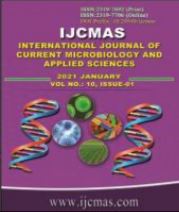


 National Academy of Agricultural Sciences (NAAS)
National Academy of Agricultural Sciences (NAAS)

|
PRINT ISSN : 2319-7692
Online ISSN : 2319-7706 Issues : 12 per year Publisher : Excellent Publishers Email : editorijcmas@gmail.com / submit@ijcmas.com Editor-in-chief: Dr.M.Prakash Index Copernicus ICV 2018: 95.39 NAAS RATING 2020: 5.38 |
This study was conducted to show plasmid profile and plasmid curing procedure and it results to determine if resistance in this study was plasmid mediated or chromosomally mediated. A total of 230 ready to eat food samples were randomly purchased, human stool of apparently healthy human volunteer and sick humans’ stool from Federal Teaching Hospital Ido (FTH) and University Teaching Hospital Ado Ekiti in Ekiti State with ethical approval from both institution , Fecal samples were also collected from forty-five (45) white broilers and fifty- nine (59) black layers from different poultry farms in Ekiti state. These samples were collected from Ekiti Central (Ado and Igede), Ekiti North (Ido and Ikole) and Ekiti South (Ikere and Emure). Samples collected were analyzed microbiologically using conventional techniques, antibiotics susceptibility testing by disc diffusion method and Double disc synergy test was used to determine β-lactamase producing bacterial isolates, the genetic basis of resistance was achieved by plasmid profiling and plasmid curing techniques. Four enteric bacteria, namely Escherichia coli, Klebsiella aerogenes, Salmonella typhi and Proteus vulgaris were isolated from the food, stool samples and majority of the bacterial isolate resistance is either plasmid or chromosomally mediated. The results showed that, someEnterobacteriaceae which include E.coli, Salmonella typhi, Klebsiellaaerogensand Proteus vulgaris from food, human and chicken stoolwas isolated carried plasmid while some did not carry plasmid. Also it shows that some resistance are plasmid mediated while some are chromosomally mediated based on the plasmid curing.
 |
 |
 |
 |
 |